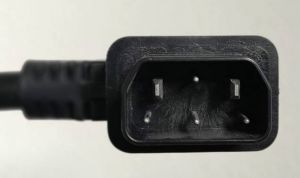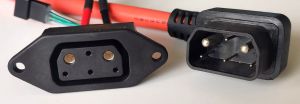Battery connector
Super Soco uses detachable batteries for their bikes. This architecture has the benefit of being able to swap the batteries and take them elsewhere for charging, which is ideal for apartment-dwellers.
Drawbacks
Being a non-permanent joint, vibrations of riding can loosen the connection strength and create a high-resistance point in the circuit. Having so much current go through this high-resistance point creates a lot of heat. The risk is even higher when the bike is unlocked. If the rider is unlucky, this can lead to welding the joint together, preventing the connector from being unpluged without completely destroying it by taking it apart. Fixing the problem usually requires replacement of both the scooter-side cable and the battery-side connector.
Types of connectors
Super Soco addresses the problems and improves on the design.
Gen 1
This is the very first connector Super Soco introduced. The voltage pins are on the narrow side of the connector. There are 4 signal pins with the following purpose:
This connector is used on all the lower-performance bikes, such as TC, TS and CUX.
Gen 1 "flat"
The voltage pins are flat which creates imperfect fit of the connector and the welding problem. Used in TC, TS, CUX until 2018/2019.
Gen 1 "round"
First improvement on the welding problem, Super Soco switched to round pins for the voltage. Used in TC, TS and CUX since 2019.
Gen 2
Next generation of the connector for higher current bikes. The voltage pins are also round, but on the wider side of the connector. There are 5 signal pins with the following purpose:
(Pins 1-3 are activated by grounding the pin to voltage negative)
These newer type batteries won't provide voltage unless activated in A or B mode. In a similar fashion, they won't accept charge unless activated in charging mode.


